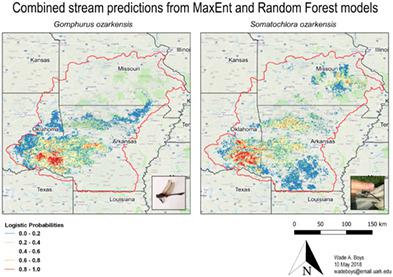当前位置:
X-MOL 学术
›
Insect Conserv. Divers.
›
论文详情
Our official English website, www.x-mol.net, welcomes your
feedback! (Note: you will need to create a separate account there.)
Predicting the distributions of regional endemic dragonflies using a combined model approach
Insect Conservation and Diversity ( IF 3.2 ) Pub Date : 2020-08-29 , DOI: 10.1111/icad.12444 Wade A. Boys 1 , Adam M. Siepielski 1 , Brenda D. Smith 2 , Michael A. Patten 2 , Jason T. Bried 3
中文翻译:

利用组合模型预测区域特有蜻蜓的分布
更新日期:2020-08-29
Insect Conservation and Diversity ( IF 3.2 ) Pub Date : 2020-08-29 , DOI: 10.1111/icad.12444 Wade A. Boys 1 , Adam M. Siepielski 1 , Brenda D. Smith 2 , Michael A. Patten 2 , Jason T. Bried 3
Affiliation

|
- Climate warming is predicted to have large effects on insects, yet several data shortfalls, including distributional information, impede effective conservation strategies.
- Knowledge of species distributions is a critical component for assessing conservation need but is often lacking for endemic or rare taxa, especially invertebrates.
- One approach to better inform this gap is by using species distribution modelling (SDM) to predict suitable habitat and guide field surveys.
- Here, we combine the predictions of two machine learning algorithms, maximum entropy and Random Forest, to estimate the current and future distributions of two endemic dragonflies of the Ozark‐Ouachita Interior Highlands region in the southcentral United States.
- Current suitable areas predicted by both algorithms largely overlapped for each species, but different environmental variables were most important for predicting their distributions. Field validation of these models resulted in new detections for both species showing their utility in guiding subsequent field surveys.
- Future projections under two climate change scenarios support maintaining current suitable areas as these are predicted to be strongholds for these species. Our results suggest that combining outputs of multiple species distribution models is a useful tool for better informing the distributions of geographically limited or rare species.
中文翻译:

利用组合模型预测区域特有蜻蜓的分布
- 预计气候变暖将对昆虫产生重大影响,但包括分布信息在内的若干数据不足阻碍了有效的保护策略。
- 物种分布的知识是评估保护需求的关键组成部分,但对于地方性或稀有生物分类群(尤其是无脊椎动物)通常缺乏了解。
- 更好地弥补这一差距的一种方法是使用物种分布模型(SDM)预测合适的栖息地并指导实地调查。
- 在这里,我们结合了两种机器学习算法(最大熵和随机森林)的预测,以估算美国中南部的Ozark-Ouachita内部高地地区的两种地方性蜻蜓的当前和未来分布。
- 两种算法预测的当前合适区域在每个物种上都有很大的重叠,但是不同的环境变量对于预测其分布最为重要。这些模型的现场验证导致对这两个物种的新检测,显示了它们在指导后续现场调查中的效用。
- 在两种气候变化情景下的未来预测都支持维持当前合适的区域,因为据预测这些区域是这些物种的据点。我们的结果表明,结合多种物种分布模型的输出是一个有用的工具,可以更好地告知地理有限或稀有物种的分布。











































 京公网安备 11010802027423号
京公网安备 11010802027423号